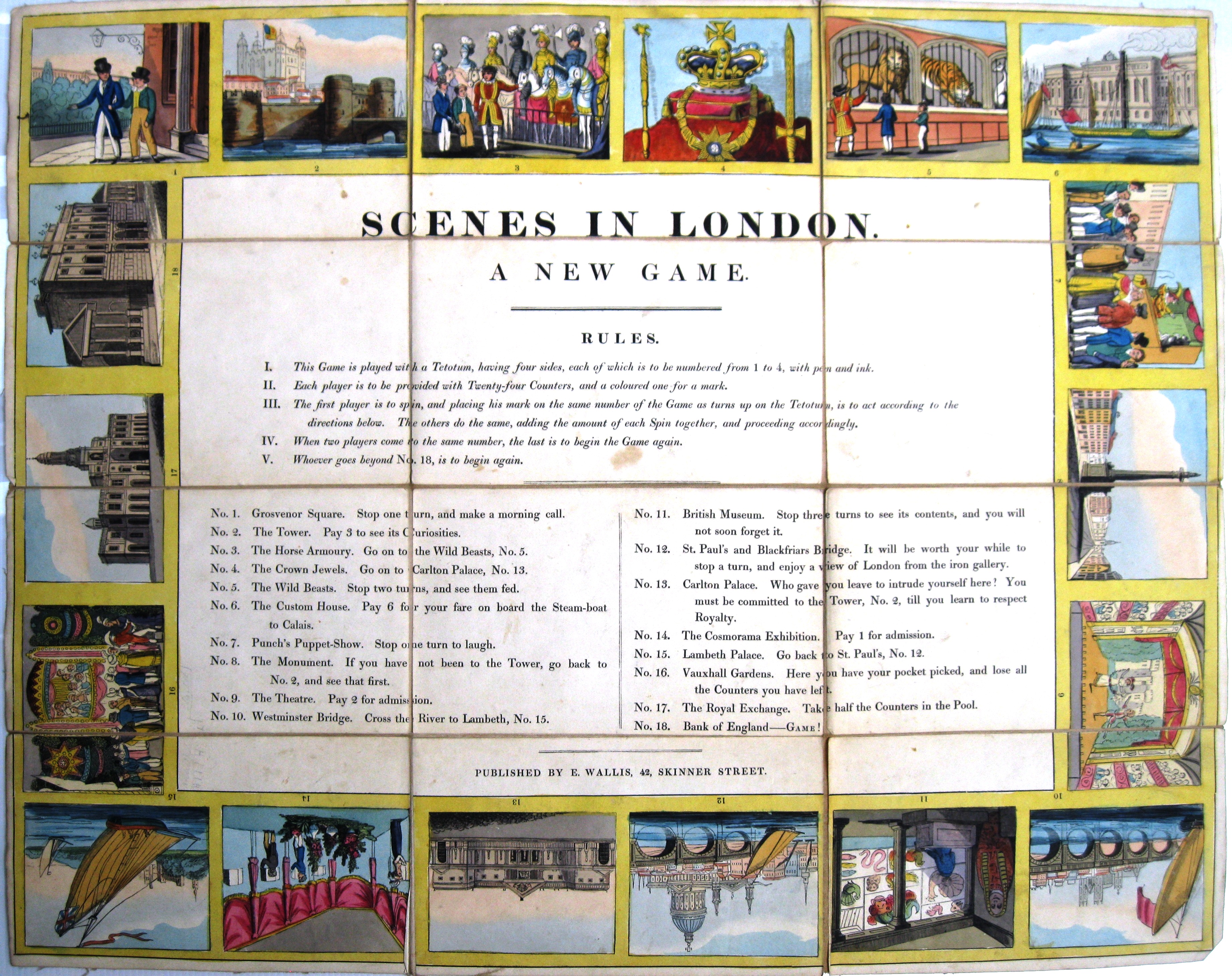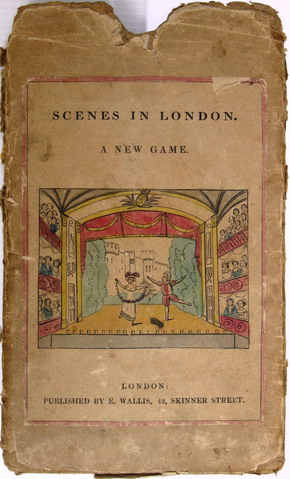Giochi dell'Oca e di percorso
(by Luigi Ciompi & Adrian Seville)
(by Luigi Ciompi & Adrian Seville)

|
Giochi dell'Oca e di percorso
(by Luigi Ciompi & Adrian Seville) |

|
 |

Torna alla ricerca giochi (back to game search) |
 |
| Scenes in London. A New Game | ||
 |
Versione stampabile
 |
Invia una segnalazione

|
 |
primo autore: | Anonimo |
| secondo autore: | Wallis | |
| anno: | 1825ca | |
| luogo: |
Inghilterra-Londra |
|
| periodo: | XIX secolo (?/4) | |
| percorso: | Percorso di 18 caselle numerate | |
| materiale: | carta incollata su tela (engraving on paper with linen backing) | |
| dimensioni: | 470X640 | |
| stampa: | Litografia colorata a mano (hand coloured engraving) | |
| luogo acquisto: | ||
| data acquisto: | ||
| dimensioni confezione: | ||
| numero caselle: | 18 | |
| categoria: | Geografia | |
| tipo di gioco: | Gioco di percorso | |
| editore: | Published by E. Wallis, 42 Skinner Street. | |
| stampatore: | Published by E. Wallis 42, Skinner Street | |
| proprietario: | Collezione A. Seville | |
| autore delle foto: | A. Seville | |
| numero di catalogo: | 2213 | |
| descrizione: |
Gioco di 18 caselle numerate che incorniciano il testo centrale con le regole. REGOLE: al centro. CASELLE: mute. REFERENZA 1 Engraved sheet, measuring 470 × 600 mm, hand-coloured, mounted on linen in 12 sections, central panel with rules printed from type, 18 London scenes round the border, original slipcase with hand-coloured pictorial label, edges somewhat frayed. A curious game with 18 London scenes. The original slipcase has a hand-coloured pictorial label showing the London Thames and in the background St. paul Cathedral, published by E. Wallis, 42, Skinner Street. Players land on numbered scenes to determine their fate, e.g. : N°13. “Carlton Palace. Who gave you leave to intrude yourself here? You must be committed to the Tower, N°2, till you learn to respect Royalty.” Scene 14 depicts the Cosmorama, N°7 Punch’s puppet show. (Paulus Swaen) REFERENZA 2 WHITEHOUSE, Francis Reginald Beaman, (pag. 39): SCENES IN LONDON Published by E. Wallis, 42 Skinner Street. An engraving size 23 ½ in X 18 ½ in, hand-coloured, mounted in 12 sections on linen, contained in slip-in case with picture label on front. The central portion is filled in by the rules printed from type, around which are 18 panels, starting at No 1 Grosvenor Square, 2 The Tower, 3 The Horse Armoury, 4 The Crown Jewels, 5 The Wild Beasts, 6 Custom House, 7 Punch’s Puppet Show, 8 The Monument, 9 The Theatre, 10 Westminster Bridge, 11 British Museum, 12 St. Paul’s, 13 Carlton Palace, 14 The Cosmerama Exhibition, 15 Lambeth Palace, 16 Vauxhall Gardens, 17 Royal Exchange, 18 Bank of England. Both panels and printing are rather coarse and far below the degree of excellence associated with this publisher. REFERENZA 3 Game 36: Scenes in London Scenes in London: a new game. London: E[dward] Wallis, 42 Skinner Street, [c. 1820]. Copper engraving with original hand color, 48 x 60 cm., dissected and laid onto linen in 4 x 3 panels, folding into slipcase with decorative label. Refs.: Ciompi/Seville 2213; Whitehouse, p. 39. This is really the simplest of race games: a rectangular track of only 18 spaces, with straightforward rules printed in the center, the shortness of the track being recognized by the use of a Teetotum numbered only up to 4. Each space depicts a different London landmark and each also has an instruction to the player, tailored to that particular location. The winning space is the Bank of England, though getting there is not without risk: No. 16 Vauxhall Gardens – Here you have your pocket picked and lose all your Counters. Edward Wallis (see Game 26) took over the business from his father in 1818 and remained at the 42 Skinner Street address until 1847. Because the date of manufacture of this game is not given, it's possible to deduce an approximate date based on the landmarks or other information in the spaces: Space 5: The Wild Beasts – Stop two turns and see them fed. The Royal Menagerie at the Tower of London dates from the reign of King John, in the 13th century, when wild animals were kept for the entertainment of the Court. In later years, it became a popular attraction but was closed after several incidents when the animals escaped, attacking staff and visitors. They were moved to the new London Zoo in 1832. Space 13: Carlton Palace – Who gave you leave to intrude here? You must be committed to the Tower, No. 2, till you learn to respect Royalty. Carlton House was the town residence of the Prince Regent from 1783. However, when he became King in 1820, he thought the house was too small. Instead of rebuilding it on a grand scale, it was decided to rebuild Buckingham House as Buckingham Palace. Carlton House was demolished in 1825. Space 14: The Cosmorama exhibition – Pay 1 for admission. The Cosmorama was a refined version of the peep show, in which the public could view well-painted scenes of distant lands and exotic subjects through optical devices that magnified the picture. The first exhibition with this title opened in 1820 in St. James’s Street but moved to Regent Street in 1823. The game therefore can be dated to c. 1820 with some confidence. (Adrian Seville) Exhibitions: - "The Royal Game of the Goose four hundred years of printed Board Games". Exhibition at the Grolier Club, February 23 - May 14, 2016 (Prof. Adrian Seville). |
|
| bibliografia: |
1) WHITEHAUSE, F.R.B.: "Table Games of Georgian and Victorian Days", London, Peter Garnett, 1951. 2) GOODFELLOW, Caroline: "A Collector's Guide to Games and Puzzles". Secaucus, New Jersey, Chartwell Books-London, Quintet Publishing Limited 1991. 3) GOODFELLOW, Caroline: "The Development of the English Board Game, 1770-1850", in Board Games Studies 1, 1998. 4) GOODFELLOW, Caroline: "Jeux de société. Le guide du collectionneur des jeux de société depuis le XVIIIe siècle jusqu’à nos jours", (Edizione francese) Carrousel MS, 2001. 5) SEVILLE, Adrian: "The Game of Goose: and its influence on cartographical race games" Journal of the International Map Collectors' Society, Winter 2008 N°115 2008. 6) SEVILLE, Adrian: "The geographical Jeux de l'Oie of Europe." In "Belgeo" 2008 3-4 2008. 7) GOODFELLOW, Caroline: "How We Played: Games From Childhood Past", History Press, 2012. 8) QUINN, Brian - CARTWRIGHT, William: "Geographic Board Games". Geospatial Science Research 3. School of Mathematical and Geospatial Science, RMIT University, Australia. December 2014. 9) SEVILLE, Adrian: "The Royal Game of the Goose four hundred years of printed Board Games". Catalogue of an Exhibition at the Grolier Club, February 23 - May 14, 2016. 10) LIMAN, Ellen: "Georgian and Victorian Board Games: The Liman Collection", Pointed Leaf Press, 2017. 11) NORCIA, Megan A.: "Gaming Empire in Children's British Board Games, 1836-1860". Studies in Childhood, 1700 to the Present. Routledge, 2019. |
|
| "The Development of the English Board Game, 1770-1850" (Caroline G. Goodfellow) | ||
| Instructional Games. "Table Games of Georgian and Victorian Days". (Francis Reginald Beaman, Whitehause) | ||
Vai alla ricerca giochi Vai all'elenco autori